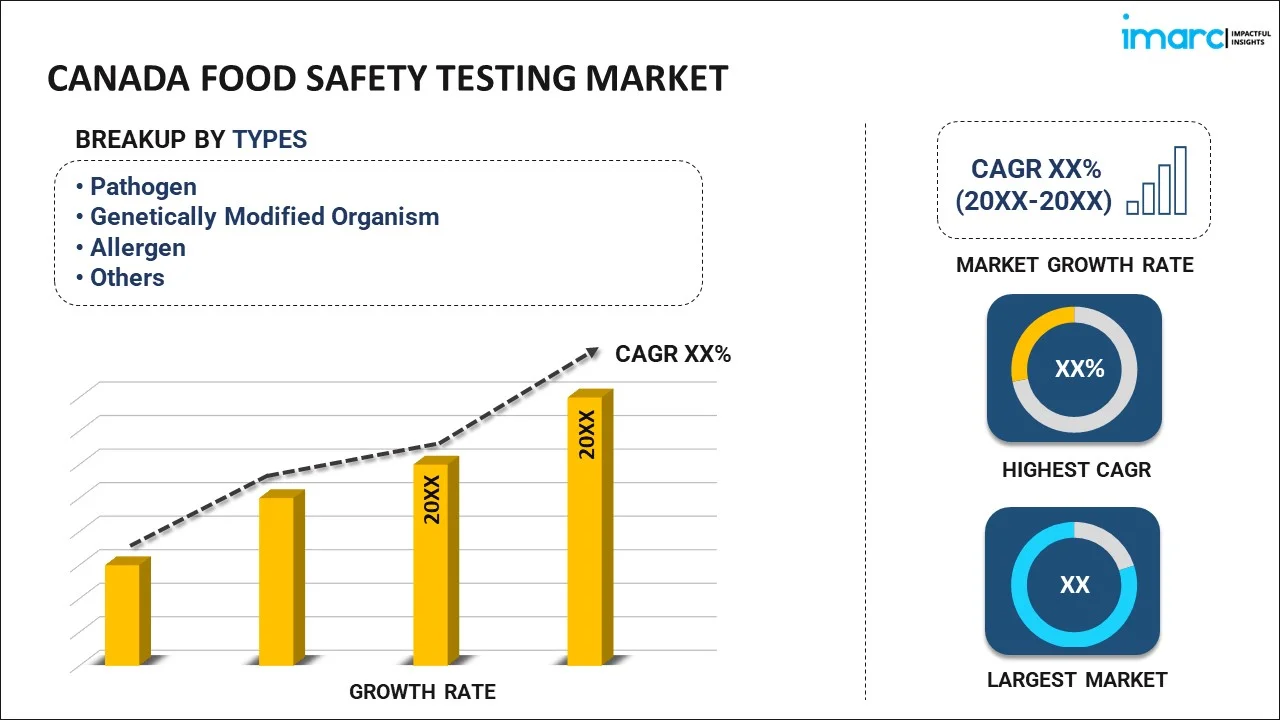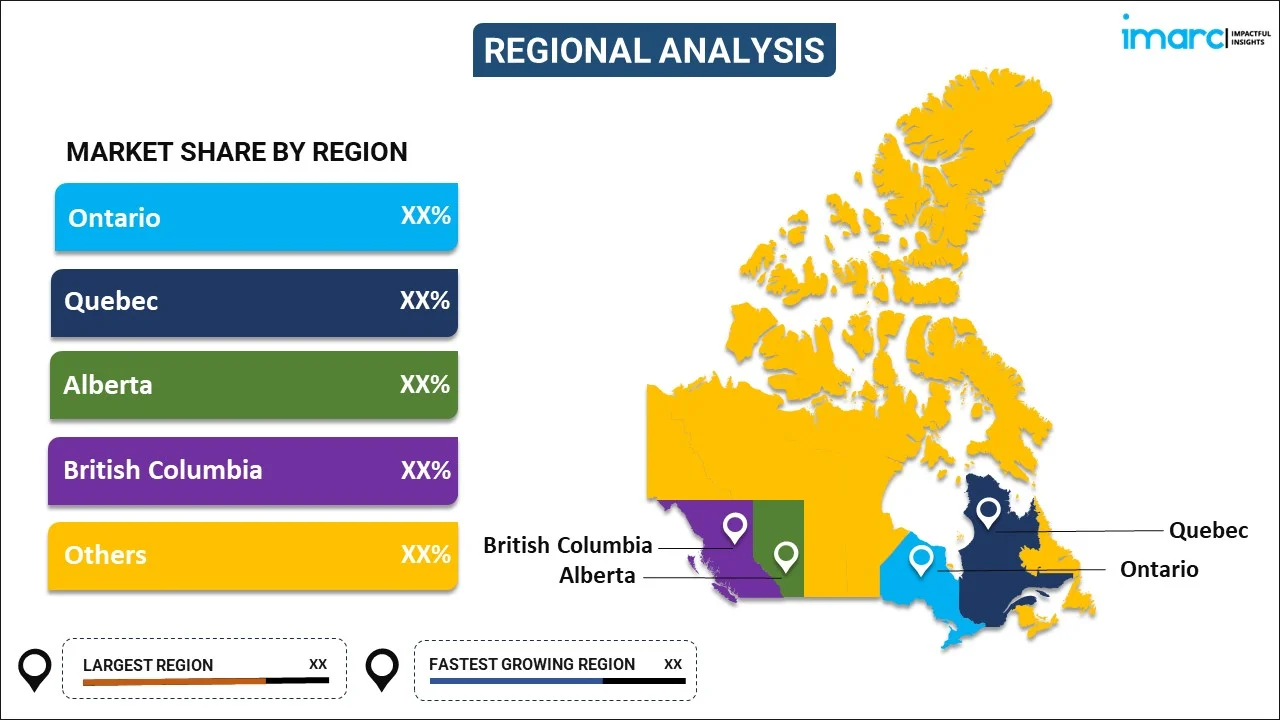
Canada Food Safety Testing Market Report by Type (Pathogen, Genetically Modified Organism, Allergen, Chemical and Toxin, and Others), Food Tested (Meat and Meat Products, Dairy and Dairy Products, Cereals, Grains, and Pulses, Processed Food, and Others), Technology (Immunoassay-based, PCR-based Assay, Agar Culturing, and Others), and Region 2024-2032
Canada Food Safety Testing Market Overview:
The Canada food safety testing market is projected to exhibit a growth rate (CAGR) of 8.60% during 2024-2032. The market is experiencing significant growth driven by the implementation of stringent regulatory requirements and food safety standards, rising incidences of foodborne illnesses and outbreaks that necessitate robust testing protocols, and heightening consumer awareness and demand for safe and high-quality food products.
|
Report Attribute
|
Key Statistics
|
|---|---|
|
Base Year
|
2023 |
|
Forecast Years
|
2024-2032
|
|
Historical Years
|
2018-2023
|
| Market Growth Rate (2024-2032) | 8.60% |
Canada Food Safety Testing Market Trends:
Regulatory Compliance and Standards
The Canadian government has some of the strict regulation policies in the world mainly enforced by agencies like the Canadian Food Inspection Agency (CFIA) in terms of food safety where robust testing is conducted for safety. During the 2020-2021 year, the CFIA tested more than 20,000 samples of food to check for compliance with the food safety regulations that help to avoid the occurrence of diseases. Every year, Canada alone experiences about 4 million incidents of diseases and testing plays an important role to check and contain the disease from spreading. This awareness among consumers to only buy products that are safe for consumption as is evident by a survey that showed that 72% of Canadians remain very concerned with the safety of the food that they eat. This fosters market expansion and emphasizes the importance of effective testing strategies. As a result, the role of the CFIA in monitoring and enforcing food safety standards is central to the government’s effort to build confidence and ensure the welfare of the consuming public in the diverse food sector in Canada.
Rising Public Health Concerns
The situation with foodborne illnesses is gradually worsening in Canada, which underlines the need to introduce more efficient tests. For instance, the Public Health Agency of Canada reports that there are about 4 million cases of illnesses, which clearly indicate the importance of the aspect of public health. Testing is equally important to quickly and efficiently isolate advent pathogens and contaminants in foods to reduce the incidence of epidemics and associated health hazards to the population. Through exercising standard compliance, regulatory organizations such as the Canadian Food Inspection Agency (CFIA) guarantee compliance with safety standards in the flow of foods through the chain. This approach does serve to protect the health of consumers and helps to enhance society’s trust in the food items that they consume. This analysis reveals that offering recurrent attention and maintaining high standards of testing procedures are critical in controlling the effects of foodborne pathogens, about which, the regulation authorities play the most crucial role in food safety in Canada.
Heightening Consumer Awareness and Demand
Growing consumer awareness about food safety issues is significantly influencing market dynamics in Canada. According to recent data from Health Canada, there are approximately 4.4 million cases of foodborne illness reported annually in Canada. This stark statistic underscores the critical need for rigorous testing and compliance with food safety standards to prevent outbreaks and protect public health. Consumers are increasingly seeking assurances of quality and safety, prompting manufacturers and retailers to prioritize compliance with regulatory requirements and invest in rigorous testing protocols. This shift in consumer behavior fosters market growth for certified safe food products and underscores the importance of transparency and accountability in the food industry. As such, businesses are compelled to align with these expectations to maintain consumer trust and meet regulatory expectations in Canada's evolving market landscape.
Canada Food Safety Testing Market News:
- In September 2023, Tahini products were recalled in Canada following Salmonella contamination detected through testing.
- In March 2024, the Canadian Food Inspection Agency (CFIA) released a comprehensive food safety testing notice to address various concerns related to food products.
Canada Food Safety Testing Market Segmentation:
IMARC Group provides an analysis of the key trends in each segment of the market, along with forecasts at the country level for 2024-2032. Our report has categorized the market based on type, food tested, and technology.
Type Insights:

- Pathogen
- Genetically Modified Organism
- Allergen
- Chemical and Toxin
- Others
The report has provided a detailed breakup and analysis of the market based on the type. This includes pathogen, genetically modified organism, allergen, chemical and toxin, and others.
Food Tested Insights:
- Meat and Meat Products
- Dairy and Dairy Products
- Cereals, Grains, and Pulses
- Processed Food
- Others
A detailed breakup and analysis of the market based on the food tested have also been provided in the report. This includes meat and meat products, dairy and dairy products, cereals, grains, and pulses, processed food, and others.
Technology Insights:
- Immunoassay-based
- PCR-based Assay
- Agar Culturing
- Others
The report has provided a detailed breakup and analysis of the market based on the technology. This includes immunoassay-based, PCR-based assay, agar culturing, and others.
Regional Insights:

- Ontario
- Quebec
- Alberta
- British Columbia
- Others
The report has also provided a comprehensive analysis of all the major regional markets, which include Ontario, Quebec, Alberta, British Columbia, and Others.
Competitive Landscape:
The market research report has also provided a comprehensive analysis of the competitive landscape. Competitive analysis such as market structure, key player positioning, top winning strategies, competitive dashboard, and company evaluation quadrant has been covered in the report. Also, detailed profiles of all major companies have been provided.
Canada Food Safety Testing Market Report Coverage:
| Report Features | Details |
|---|---|
| Base Year of the Analysis | 2023 |
| Historical Period | 2018-2023 |
| Forecast Period | 2024-2032 |
| Units | US$ Million |
| Scope of the Report | Exploration of Historical Trends and Market Outlook, Industry Catalysts and Challenges, Segment-Wise Historical and Future Market Assessment:
|
| Types Covered | Pathogen, Genetically Modified Organism, Allergen, Chemical and Toxin, Others |
| Food Tested Covered | Meat and Meat Products, Dairy and Dairy Products, Cereals, Grains, and Pulses, Processed Food, Others |
| Technologies Covered | Immunoassay-based, PCR-based Assay, Agar Culturing, Others |
| Regions Covered | Ontario, Quebec, Alberta, British Columbia, Others |
| Customization Scope | 10% Free Customization |
| Post-Sale Analyst Support | 10-12 Weeks |
| Delivery Format | PDF and Excel through Email (We can also provide the editable version of the report in PPT/Word format on special request) |
Key Questions Answered in This Report:
- How has the Canada food safety testing market performed so far and how will it perform in the coming years?
- What has been the impact of COVID-19 on the Canada food safety testing market?
- What is the breakup of the Canada food safety testing market on the basis of type?
- What is the breakup of the Canada food safety testing market on the basis of food tested?
- What is the breakup of the Canada food safety testing market on the basis of technology?
- What are the various stages in the value chain of the Canada food safety testing market?
- What are the key driving factors and challenges in the Canada food safety testing?
- What is the structure of the Canada food safety testing market and who are the key players?
- What is the degree of competition in the Canada food safety testing market?
Key Benefits for Stakeholders:
- IMARC’s industry report offers a comprehensive quantitative analysis of various market segments, historical and current market trends, market forecasts, and dynamics of the Canada food safety testing market from 2018-2032.
- The research report provides the latest information on the market drivers, challenges, and opportunities in the Canada food safety testing market.
- Porter's five forces analysis assist stakeholders in assessing the impact of new entrants, competitive rivalry, supplier power, buyer power, and the threat of substitution. It helps stakeholders to analyze the level of competition within the Canada food safety testing industry and its attractiveness.
- Competitive landscape allows stakeholders to understand their competitive environment and provides an insight into the current positions of key players in the market.
Need more help?
- Speak to our experienced analysts for insights on the current market scenarios.
- Include additional segments and countries to customize the report as per your requirement.
- Gain an unparalleled competitive advantage in your domain by understanding how to utilize the report and positively impacting your operations and revenue.
- For further assistance, please connect with our analysts.
 Inquire Before Buying
Inquire Before Buying
 Speak to an Analyst
Speak to an Analyst
 Request Brochure
Request Brochure
 Request Customization
Request Customization




.webp)




.webp)












